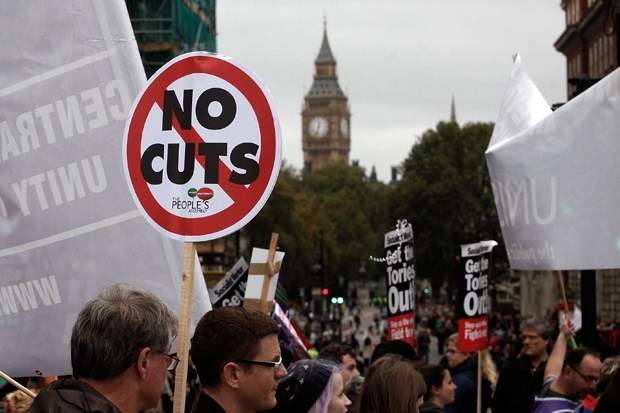What a beautiful day, I thought, as I nodded to the porter in the bowler hat and stepped out of the Westminster hotel into October sun and wind, with a dramatic, fast-forwarding sky overhead, and the dry crackle of leaves underfoot. Lovely London. Solid, masculine, powerful, exciting London. Beautiful London. Outside Westminster Abbey the pavements were thronged with tourists pointing their cameras and smartphones at anything and everything, from the traffic cops to the decorative spikes on the railings. Pret à Manger was packed with riot police in full battledress queueing nicely for their mid-morning caffeine fix.
I crossed over the road into Parliament Square and passed a statue of what looked like a black troll. The figure was stooped, possibly owing to the weight of its oversized head. Closer inspection revealed that it was a statue of Nelson Mandela. His outstretched hands were positioned like those of the fisherman boasting ‘it was that big’. Everything about this statue — the execution, the small, democratic plinth, the aimless alignment — struck me as comically botched. But it might have been just me. And on this lovely mid-autumn Saturday morning, I wasn’t going to start making fatuous judgments about art. Not when it was feeling this good to be alive and part of a London crowd, and with the added drama of a police chopper thrumming low over our heads, and the sound of distant hysterical drumming coming from the direction of Trafalgar Square.
Next to Nelson Mandela a copper was explaining to a sullen young Occupy activist Parliament Square’s new ‘no camping’ laws, drawn up especially to evict the anti-war demonstrator Brian Haw, who lived in a tent on its lawn for ten years. I once spent the night with Brian Haw. He was a deep mahogany colour and rather superior. I was supposed to write about him for a newspaper. But he was supercilious towards me. The only thing he said to me all night was: ‘You’re drunk. I don’t like drunks.’ But you couldn’t help respecting a man so zealous for justice that he left his wife and seven children to go and live in a tent in Parliament Square. I only hope that unlike Nelson Mandela’s, Brian’s statue, when he gets one, is going to have a proper plinth.
I crossed the road from beside Churchill’s statue and headed up Whitehall, which was closed to traffic. Beyond the Cenotaph, and near enough to be competing with it, was a massive monument to the Women of World War II. ‘Let the women of Britain come forward,’ said Churchill. Seven million volunteered. And here was their monument: a forbidding 22-foot-high bronze block around which hangs a row of crudely rendered uniforms, as on a coat rack at a party. At first glance I didn’t notice that the uniforms were empty and I assumed I was looking at a rendering of a gallows with multiple hangings. The thing is so brutish, Lutyens’s Cenotaph looks feminine by comparison.
But what do I know about art? I don’t even know what I like. And I was feeling so good, so alive, and so in love with London, that I mentally apologised to myself, God and the universe for slipping into judgmental nitwit mode again, and I headed on up the road towards the drumming and the tumults in Trafalgar Square.
The buildings of Whitehall looked splendid, almost magical in the sunshine. The north end was cordoned off to allow a demonstration by 80,000 public sector workers to pass by. I stood for half an hour and looked at the passing faces and the banners and read the placards. There it was, in the flesh: the public sector. The march was efficiently corralled by trade union stewards and not in the slightest bit confrontational. The riot police in Pret à Manger could quietly sip their coffees and maybe order a bacon, brie and pear on artisan bread to eat in. A few marchers looked enraged by what the government had done to them personally, but most were cheerful and clearly out to enjoy themselves, the nurses particularly. I was pleased to see my old trade union, the General, Municipal, Boilermakers and Allied Trade Union, march past in close formation with purposeful faces to a military-style drumbeat, exactly like marching workers on the old Soviet propaganda posters.
I stood and looked at all those sunlit public sector worker faces and felt so at peace with myself and the world that I loved these public sector marchers, every one. How beautiful London is, I thought. And how beautiful are the people in it. In a world as beautiful as this, I thought, why would anyone want to take drugs? And then I remembered that I was on drugs, and had been since yesterday, and that all this love I was feeling was probably only temporary.







Comments